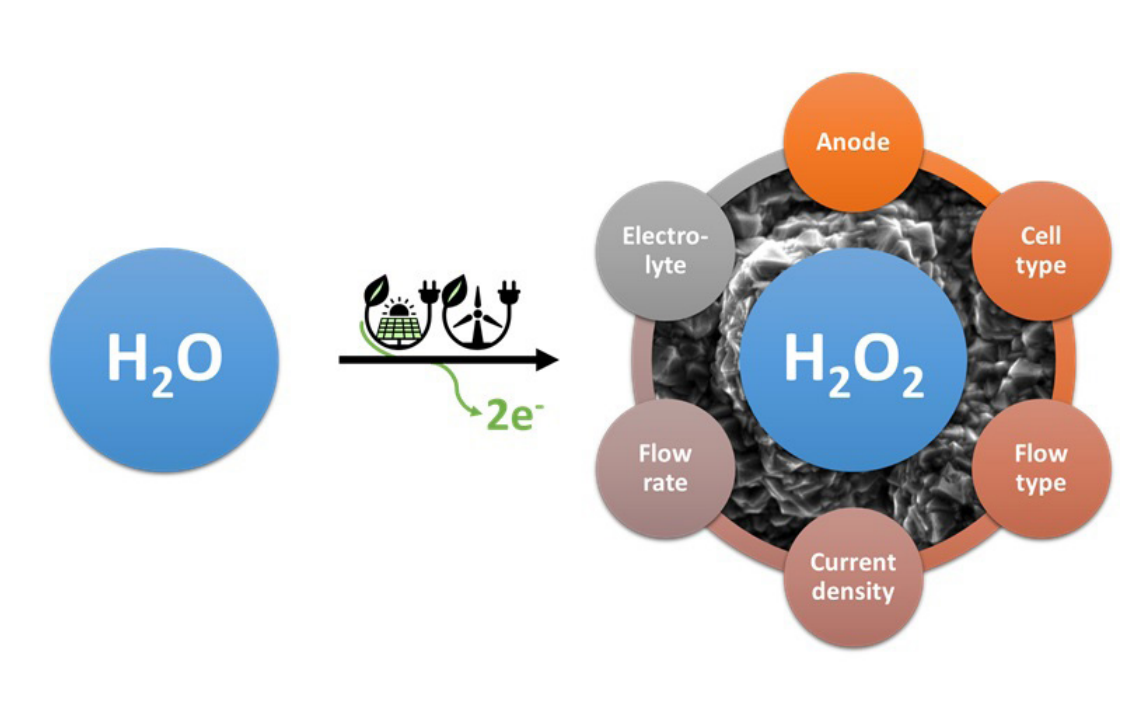Hydrogen peroxide (H2O2) is an environmentally friendly oxidant widely used in the chemical industry. However, the classic production method is expensive and not suitable for decentralized application on a small scale. For this reason, researchers at Fraunhofer IGB have been working on an alternative electrochemical process in the CO2EXIDE project. This is now being further developed and demonstrated in the EU-funded follow-up project POWER2HYPE together with partners from industry and research.
POWER2HYPE – Electrochemical synthesis of hydrogen peroxide from water, air and renewable electric energy

Electrochemical production of H2O2 – further development in large-scale international project
Hydrogen peroxide (H2O2) is an oxidant widely used in the chemical industry. It is considered environmentally friendly as it releases only water and oxygen upon decomposition. At present, 95 percent of the world’s annual H2O2 production of about 5.5 million tons is based on the anthraquinone process – a costly method and impractical for routine on-site application at a small scale. Alternatively, H2O2 can be synthesized electrochemically via oxygen (O2) reduction or water (H2O) oxidation, which is cost-efficient and applicable on both large and small scales.
Successful anodic oxidation in continuous flow cell
As part of the EU-funded CO2EXIDE project, researchers at Fraunhofer IGB have already developed a process for two electron (2e-) H2O oxidation to H2O2. Various carbon-based materials, including carbon paper, boron-doped diamond, and graphite bipolar plate, have been investigated as anodes in the electrochemical synthesis of H2O2 at high current densities in a continuous flow. Broad range of operating parameters, including the electrolyte concentration, pH, and the presence of a chemical stabilizer, substantially increases the selectivity towards H2O2 generation using optimized parameters.
Further development and demonstration
The new European project POWER2HYPE, funded through EU’s Horizon Europe program and coordinated by Fraunhofer IGB, aims to establish a sustainable route for H2O2 production.
An innovative custom-made electrolyzer will be used to produce H2O2 at both the cathode and anode, using air and water as feedstock and renewable energy as the sole energy source. The researchers at Fraunhofer IGB will be working together with the partners to electrochemically produce H2O2 in high concentrations (from 20 to 99 wt.%). In this way, electrosynthesized H2O2 can be used for a wide range of applications, from sanitation, bleaching, to niche markets such as a propulsion fuel.
Literature
[1] Pangotra, D., Csepei, L.I., Roth A., Ponce de León, C., Sieber, V., Vieira, L. (2022) Anodic production of hydrogen peroxide using commercial carbon materials, Applied Catalysis B: Environmental Vol: 303
https://doi.org/10.1016/j.apcatb.2021.120848
[2] Pangotra, D., Csepei, L.I., Roth A., Sieber, V., Vieira, L. (2022) Anodic generation of hydrogen peroxide in continuous flow, Green Chemistry 24, 7931-7940
https://doi.org/10.1039/D2GC02575B
[3] Pangotra, D., Roth A., Sieber, V., Vieira, L. (2023) Electrochemical Water Oxidation to Hydrogen Peroxide on Bipolar Plates, ACS Sustainable Chemistry & Engineering
Project information
Project title
POWER₂HYPE – Electrochemical synthesis of hydrogen peroxide from water, air and renewable electric energy
Project duration
January 2023 – December 2026
Project partners
- Wageningen University, the Netherlands
- Stichting Wageningen Research, the Netherlands
- Friedrich-Alexander University of Erlangen-Nürnberg, Germany
- DIACCON, Germany
- Energieinstitut an der Johannes Kepler University of Linz Verein, Austria
- SOLVAY SA, Belgium
- Tecnicas Reunidas SA, Spain
- SGL Fuel Cell Components GmbH, Germany
- Solvge B.V., the Netherlands
- Globaz, S.A., Portugal
- IRIS Technology Solutions, Sociedad Limitada, Spain
Project coordination
- Fraunhofer Institute for Interfacial Engineering and Biotechnology IGB (Dr. Arne Roth)
Funding
REPowerEU (Grant agreement ID: 101091934)
 Fraunhofer Institute for Interfacial Engineering and Biotechnology IGB
Fraunhofer Institute for Interfacial Engineering and Biotechnology IGB